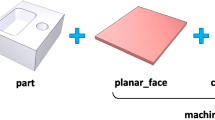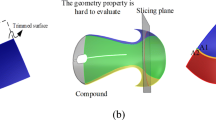Abstract
In industry, many taper shafts are designed with tolerances of a few microns. To cut them in finish turning, paths of the tool in virtual machining should be accurately generated beforehand. For this purpose, the dimension errors and surface roughness of the virtually cut workpiece should be predicted. Unfortunately, the current tool path generation methods cannot accurately calculate the errors and the roughness, resulting in the taper errors larger than the part tolerance. Our research formulates equations of the effective turning edge to accurately calculate the dimension errors and the surface roughness, and then proposes a new approach to CNC programming for high-precision CNC turning. It lays a theoretical foundation of modeling parts in virtual turning and can generate tool paths to machine taper parts with high accuracy.
Similar content being viewed by others
References
Jang DY, Choi YG, Kim HG, Hsiao A (1996) Study of the correlation between surface roughness and cutting vibrations to develop an on-line roughness measuring technique in hard turning. Int Mach Tools Manuf 36(4):453–464
Özel T, Hsu TK, Zeren E (2005) Effects of cutting edge geometry, workpiece hardness, feed rate and cutting speed on surface roughness and forces in finish turning of hardened AISI H13 steel. Int J Adv Manuf Technol 25(3–4):262–269
Pavel R, Marinescu I, Deis M, Pillar J (2005) Effect of tool wear on surface finish for a case of continuous and interrupted hard turning. J Mater Process Technol 170:341–349
Grzesik W, Wanat T (2006) Surface finish generated in hard turning of quenched alloy steel parts using conventional and wiper ceramic inserts. Int J Mach Tools Manuf 46:1988–1995
Risbood KA, Dixit UA, Sahasrabudhe AD (2003) Prediction of surface roughness and dimensional deviation by measuring cutting forces and vibrations in turning process. J Mater Process Technol 132:203–214
Jiao Y, Lei S, Pei ZJ, Lee ES (2004) Fuzzy adaptive networks in machining process modeling: surface roughness prediction for turning operations. Int J Mach Tools Manuf 44:1643–1651
Özel T, Karpat Y (2005) Predictive modeling of surface roughness and tool wear in hard turning using regression and neural networks. Int J Mach Tools Manuf 45:467–479
Asilturk I, Cunkas M (2011) Modeling and prediction of surface roughness in turning operations using artificial neural network and multiple regression method. Expert Syst Appl 38:5826–5832
Pontes JF, Paiva APd, Balestrassi PP, Ferreira JR, Silva MBd (2012) Optimization of radial basis function neural network employed for prediction of surface roughness in hard turning process using Taguchi’s orthogonal arrays. Expert Syst Appl 39:7776–7787
Suneel TS, Pande SS (2000) Intelligent tool path correction for improving profile accuracy in CNC turning. Int J Prod Res 38(4):3181–3202
Li X, Du R (2002) Analysis and compensation of workpiece errors in turning. Int J Prod Res 40(7):1647–1667
Topal ES, Cogun C (2005) A cutting force induced error elimination method for turning operations. J Mater Process Technol 170:192–203
Zhao Y, Ridgway K, Al-Ahmari AMA (2002) Integration of CAD and a cutting tool selection system. Comput Ind Eng 42:17–34
Balic J, Kovacic M, Vaupotic B (2006) Intelligent programming of CNC turning operations using genetic algorithm. J Intell Manuf 17:331–340
Chauhan P, Pant M, Deep K (2015) Parameter optimization of multi-pass turning using chaotic PSO. Int J Mach Learn Cybern 6:319–337
Smid P (2000) CNC programming handbook: comprehensive guide to practical CNC programming. Industrial Press Inc.
Acknowledgements
The financial support of this work from the National Natural Science Foundations of China (Grant No. 51475381 and 51375395) and Natural Science Basic Research Plan of Shaanxi Province (Grant No. 2016JM5040) is thankfully acknowledged.
Author information
Authors and Affiliations
Corresponding author
Rights and permissions
About this article
Cite this article
Chang, Z., Chen, Z.C., Wan, N. et al. A new mathematical method of modeling parts in virtual CNC lathing and its application on accurate tool path generation. Int J Adv Manuf Technol 95, 243–256 (2018). https://doi.org/10.1007/s00170-017-1202-4
Received:
Accepted:
Published:
Issue Date:
DOI: https://doi.org/10.1007/s00170-017-1202-4




